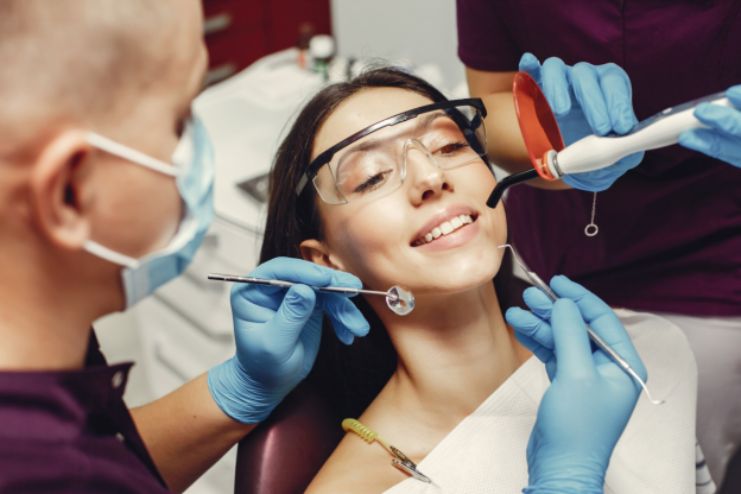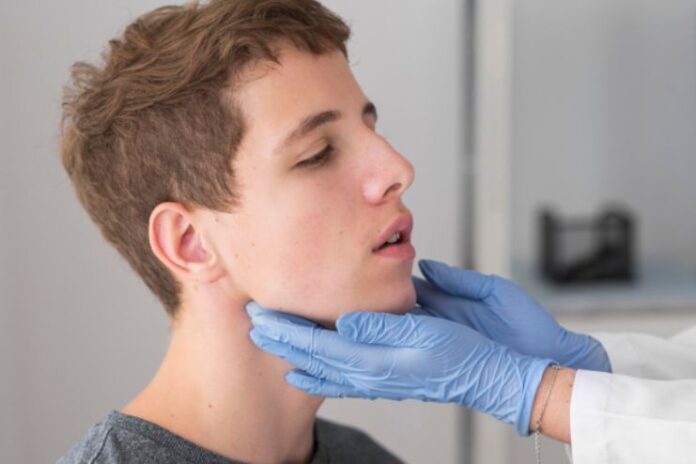Affiliate Disclaimer
Some links in this article are affiliate links. We may earn a small commission if you make a purchase through these links, at no extra cost to you. We only recommend products we find useful to our readersMost people fail to recognize that jaw alignment plays an important role in one’s health. A misaligned jaw can lead to postural complications, affect the way you breathe, and even disturb your sleep, thereby contributing to chronic pain, induced tension, and sleep disorders.
If the jaw is not in the correct position, it sets off an entire train of dysfunction where the neck and spine bear the majority of compensatory strain, airflow passages are restricted, TMJ disorders manifest, sleep apnea occurs, and fatigue becomes chronic.
Learning the connection between jaws, posture, and breathing is an important key to enhancing not just your dental areas but the well-being of your entire body.
This article will explore how jaw misalignments affect breathing, posture, and sleep, how to recognize signs of imbalance, and practical keys to restoring that alignment for a healthier, more relaxed existence.
Also, Read: 10 Best Posture Support Products for Work: Ergonomic Must-Haves
How Jaw Alignment Affects Posture

Your jaw alignment gives your head and spine the balance they need to keep you perfectly upright. Any jaw misalignment disturbs this balance, leading to various postural problems.
The Relation of the Jaw with Neck and Spine Alignment
The jaw or temporomandibular joint is very closely related to the neck and even the spine (R). Well-aligned jaws will help support the balanced position of the head over the spine and promote correct posture.
On the contrary, a misaligned jaw will shift the positioning of the head out of its natural position, straining the neck and spinal muscles further. The alignment pull also manifests compensatory changes throughout the musculoskeletal system, thus altering body posture.
Influence on Muscle Balancing and Bodily Motion
Misalignment in the jaws can lead to muscle imbalance, mostly concerning the neck, shoulders, and back (R). This condition makes some muscles work more than usual, while others grow weaker and deprive an ideal body mechanism. The whole effect over time can bring about chronic pain, stiffness in any movement, and more postural deformities.
Most importantly, misalignment of the jaws will always be a critical consideration in posture. Correcting jaw malalignment will lead to significant improvements in posture and relief from related pain.
Jaw Alignment & Breathing: Is Your Bite Restricting Your Airways?

Your jaw position is critical for proper breathing. A misaligned jaw can constrict your airway, making it harder for you to breathe, especially during sleep. This can lead to snoring, mouth breathing, and sleep apnea issues.
Airway Obstruction and Mouth Breathing: The Role of the Misaligned Jaw
When misaligned, the jaw can push the tongue back, partially blocking the airway (R). You, therefore, tend to breathe through your mouth instead of your nose, resulting in dry mouth, throat irritation, and decreased oxygen. Mouth breathing also has a negative effect on the development of the face and health.
Connection to Conditions Like Sleep Apnea, Snoring, and Chronic Nasal Congestion
Jaw misalignment contributes to the pathogenesis of obstructive sleep apnea (OSA), which is otherwise defined as sleep-disordered breathing. The jaw position can collapse the airway during sleep, hinder breathing, and reduce sleep quality.
Additionally, snoring and chronic nasal congestion emerge as signs of airway obstruction related to jaw misalignment.
How Restricted Airway Affects Oxygen Intake and Respiratory Health
With a restricted airway, oxygen intake is reduced; hence, over time, fatigue, cognitive impairment, and cardiovascular issues begin to manifest (R). On the contrary, when the jaw aligns, it keeps the airway well open for maximum gas exchange and respiratory health benefits.
Understanding this relationship can help you make further efforts toward improvement. If you are experiencing symptoms of mouth breathing, snoring, or sleep apnea, see a dentist or orthodontist specializing in airway health.
The Link Between Jaw Position and Sleep Quality

Jaw position affects sleep quality. Jaw misalignment, commonly seen with temporal-mandibular joint (TMJ) disorders, will produce sleep disturbances.
Sleeping Disorders Influence Sleep Quality
Pain and Discomfort: Temporal-mandibular joint (TMJ) disorders create pain and muscular tension, making it challenging for a comfortable sleeping position. This pain can cause constant awakenings and decreased sleep quality.
Sleep Disruptions: The discomfort caused by TMJ disorders often leads to sleep disruptions, thereby affecting rest quality.
Connection to Sleep Disorders
Sleep Apnea: There is a good association between TMJ disorders and sleep apnea (R). Almost three-quarters of individuals with TMJ disorders are additionally faced with sleep breathing disorders occurring from an obstructed airway, the commonest of which could be obstructive sleep apnea (OSA).
This relationship indicates that jaw misalignment must affect airway obstruction during sleep, resulting in stopping breathing.
Bruxism (Teeth Grinding): Jaw misalignment can lead to bruxism (R), which is the grinding or clenching of teeth during sleep. This act worsens TMJ symptoms and further fragments sleep cycles, denying restorative sleep.
Influence of Sleep Position
Supine Sleeping: Sleeping on your back is said to be the best position for relieving TMJ pain (R). This position applies no pressure on one’s jaw and helps keep the head and neck in alignment, thereby reducing muscle tension and pain from TMJ.
Keeping jaw alignment sound is important for sleep quality. Treating misalignment gives good results in aiding sleep and general health.
Also, Read: Mouth Taping for Sleep: Does It Really Improve Breathing and Sleep Quality?
Signs Your Jaw Alignment Might Be Off

Jaw alignment problems can produce symptoms that affect the way you posture, breathe, and sleep. Not many patients relate discomfort and those symptoms with jaw realignment problems. The following points talk about some significant signs:
1. Jaw Pain and Discomfort
- The presence of recurrent pain or tender sensations in the region of the jaw, especially in the areas surrounding the temporomandibular joint (TMJ).
- Difficulties or discomfort experienced when chewing, speaking, or even opening the mouth.
- Clicking, popping, or grinding sounds may be heard when jaw movements occur.
2. Headaches and Facial Tension
- Tension headaches, especially in the temple, forehead, or even behind the eyes.
- Pain or tightness is located on the face around the cheeks and ears.
- Migraine that is experienced after clenching the jaw or the grinding of teeth (bruxism).
3. Neck, Shoulder, and Back Pain
- The alignment of the jaw can subsequently cause imbalances in the associated muscles, leading to chronic neck and shoulder pain.
- Poor jaw positioning causes the spine to malfunction and leads to postural hampering and occasional pain in the upper and lower parts of the back.
4. Breathing and Sleeping Difficulties
- Breathing through the mouth and even during the night has difficulties, particularly in the nasal sector.
- Snoring, sleep apnea, or waking up gasping for air due to restricted airways.
- Poor sleep quality, too many awakenings, or excessive daytime fatigue.
5. Bite Irregularities and Tooth Wear
- The teeth are not fitting at closure.
- Inevitably, uneven tooth wear or even enamel erosion due to grinding excessively.
- Sensitivity or pain in some teeth is associated with misalignment.
6. Postural Changes and Balance Problems
- Forward head posture or tilting of the head to one side.
- Unevenness while walking or feeling unsteady.
- Chronic muscle tightness in the jaw, neck, and upper body.
Self Exam: Assess Your Jaw Alignment
- Face a mirror, then slowly open and close your mouth. If your jaw shifts to one side, it’s misaligned.
- Now, gently press your fingers on either side of the jaw. If it clicks or is tender, your TMJ may be affected.
- Check how your teeth come together when you bite down. Uneven pressure could indicate a problem with a jaw.
When you notice numerous symptoms, visiting a dentist, orthodontist, or physical therapist specializing in TMJ disorders and jaw alignment could help you determine the best course of action.
Ways to Improve Jaw Alignment for Better Health

Improvement in jaw alignment increases posture, breathing, and sleeping quality while decreasing pain and discomfort. The following are different treatment modalities and self-help approaches for correcting malocclusion and enhancing holistic well-being:
1. Orthodontics
Braces & Invisalign: Traditional braces and transparent alignment systems reposition the teeth and correct bite problems that cause jaw misalignment.
Occlusal Splint & Mouthguard: Customized dental appliances will help stabilize the jaw and lower strain from teeth grinding (bruxism).
2. Myofunctional Therapy & Tongue Posture Training
Myofunctional Exercises: Targeted exercise would build strength in the tongue, facial, and jaw muscles needed for proper alignment.
Correct Tongue Posture: The roof of the mouth supports jaw positioning and airway obstruction reduction, though the tongue should rest against it.
3. Chiropractic & Physical Therapy for Jaw Alignment
Postural Corrections: The neck and back muscle strength support the natural alignment of the jaw.
Manual Adjustments: Aligning the jaw and cervical spine by chiropractic practice and physical therapy helps alleviate tension and improves the functioning of the entire system.
4. Breathing Exercises for Jaw and Airway Function
Diaphragmatic Breathing: This technique works well for the lungs, has a nasal-dominated flow, and puts little strain on the jaw.
Buteyko Method: A course of structured breathing techniques can dramatically improve the patient’s control and nasal airflow and prevent jaw opening due to constricted nasal breathing.
5. Lifestyle Changes & Home Remedies
Avoid Hard & Chewy Foods: Jaw muscle strain can be added to poor alignment from excessive chewing.
Maintain Proper Sleep Posture: Sleeping on one’s back with head stabilizing and neck support can help prevent misalignment.
Reduce Clenching & Grinding: Manage stress using a mouthguard, which protects the jaw from any extra tension.
6. Surgical & Medical Interventions for Adverse Cases:
Orthognathic Surgery: This is a surgical technique for severe jaw malocclusion that cannot be treated with orthodontics alone.
TMJ Arthroscopy: A minimally invasive procedure for the treatment of temporomandibular joint (TMJ) disorders.
Also, Read: 10 Best Night Guards for Teeth Grinding You Didn’t Know About
Final Thoughts: Should You Get Your Jaw Alignment Checked?
Jaw alignment interplays with breathing, posture, and sleep quality, becoming a vital factor beyond dental concern.
An unaligned jaw can cause an imbalance in the head and spine, causing muscle strain and restricting the airway. This can thereby contribute to TMJ disorders, sleep apnea, and chronic pain. Failure to treat these disorders can lead to health complications, such as fatigue, poorly oxygenated blood, and postural imbalances.
If you observe any signs of jaw misalignment, e.g., a headache caused by not being able to breathe or sleep, that is when you can do something about it. Little things in lifestyle changes, targeted exercises, orthodontic treatments, or professional interventions should restore that alignment, free you from discomfort, and set the stage for better health.
Once symptoms of misalignment manifest, pursuing a consultation and treatment plan with a dentist, orthodontist, or physical therapist who specializes in jaw health is a worthy consideration.
Some simple adjustments can create quite a difference in how one feels with enhanced posture, breathing, and sleeping. Therefore, prioritizing jaw health is a step towards a healthier and more balanced life.
References
- https://www.freshorthodontics.com/surprising-connection-between-your-posture-and-your-jaw/
- https://millenniumsmiles.com/how-your-misaligned-jaws-can-cause-chronic-pain/
- https://www.dentaltmjpain.com/blog/how-tmj-disorders-affect-sleep-and-what-to-do-about-it/
- https://www.ua5pointsdentistry.com/how-does-your-tmj-affect-your-sleep/
- https://www.tmjtexas.com/sleeping-soundly-how-sleep-studies-can-help-diagnose-tmj-disorders
- https://www.suburbantmjcenter.com/sleep-tmj-connection-sleep-and-jaw-health
- https://www.sleepandtmjcenter.com/proper-sleep-position-tmj-and-sleep-apnea-relief
- https://pubmed.ncbi.nlm.nih.gov/11894202/
- https://stsmiles.com/blog/underdeveloped-jaws/
- https://www.sleepandtmjcenter.com/proper-sleep-position-tmj-and-sleep-apnea-relief
- https://tmjsleepandbreathecenter.com/link-between-airway-breathing-sleep-apnea-problems-bad-posture/
- https://pubmed.ncbi.nlm.nih.gov/11894202/
- https://www.midwestheadaches.com/patient-education/resting-posture-really-matters/
- https://www.severnsdentistry.com/how-orthodontic-treatment-can-correct-jaw-alignment-issues
- https://vivos.com/how-does-myofunctional-therapy-support-proper-jaw-development/
- https://parkaveortho.com/orthodontic-treatment-options-for-jaw-repositioning/
- https://www.sleepandtmjcenter.com/myofunctional-therapy-sleep-apnea-and-tmj-disorders
In this Article

















